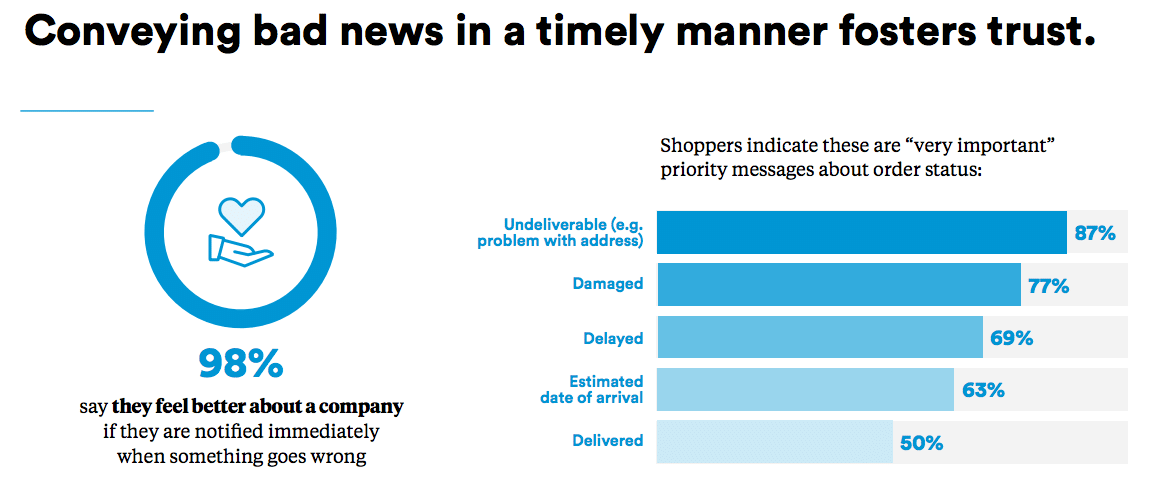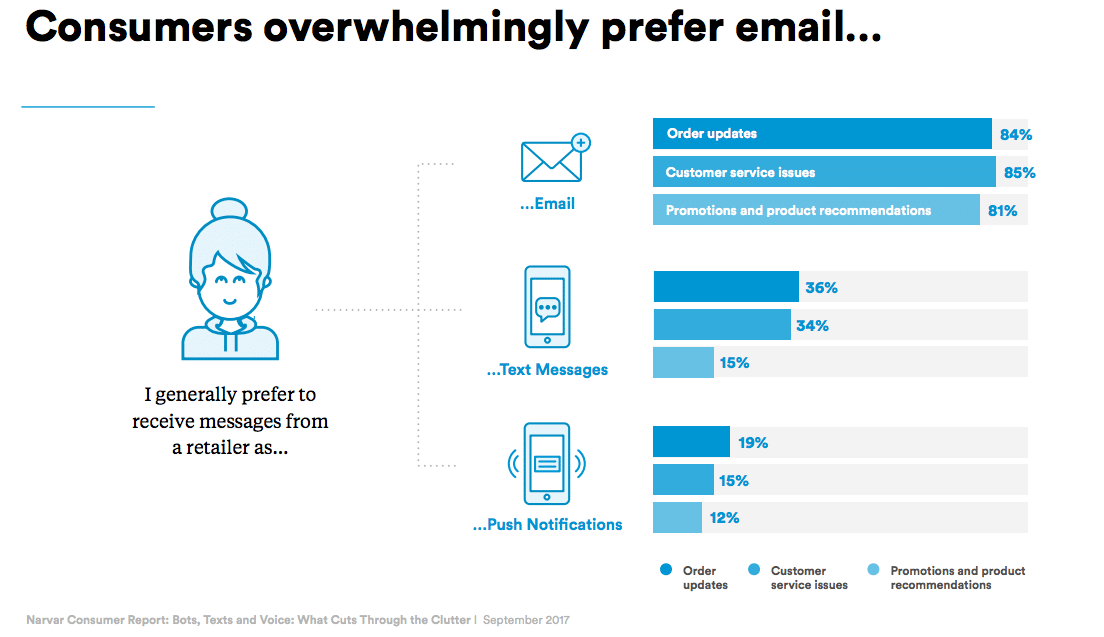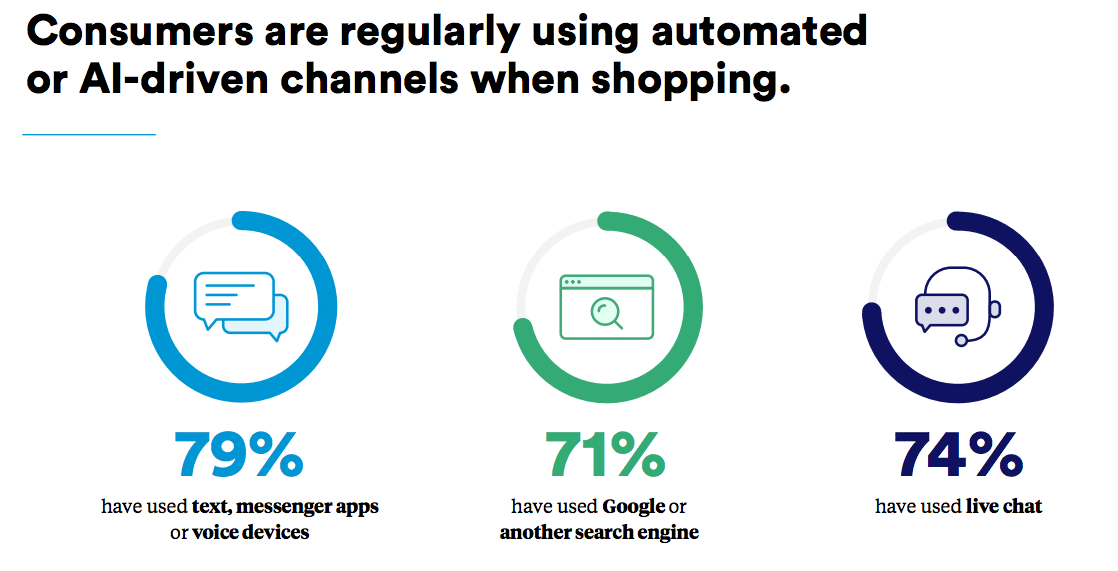People are exhibiting more complex and varied preferences for how, where and why they communicate with retailers, amplified by contrasting preferences between generations in the face of emerging technology, according to a new report from brand relationship and post-purchase experience firm Narvar, Bots, Texts and Voice: What Cuts Through the Clutter.
“Bots, voice assistants, smart homes and other AI-informed communications are top of mind for nearly every retailer today. The technology innovation complicates what we already know—that customer communications are never one-size-fit-all,” says Amit Sharma, CEO of Narvar, in a news release. “With this research, our mission is to equip retailers with the insights they need to navigate nuanced communications and ultimately create the best experiences possible.”
Seventy-seven percent of American adults own a smartphone; every month, people exchange 2 billion messages with Facebook Messenger’s 100,000 active bots, and 30 million households will have a voice-first, in-home device such as Amazon Echo and Google Home by the end of 2017—and these technology-driven communication channels are starting to change the way people want to interact with retailers. While more than 80 percent prefer to get messages from retailers via email, 38 percent now want to hear from retailers on multiple channels. According to the survey, 79 percent of shoppers have also used text messages, messenger apps or voice devices to connect with retailers.
“People expect a personalized, effortless online shopping experience from discovery to post-purchase. This is only amplified with the introduction of new communications channels,” said Sucharita Mulpuru, a retail industry analyst who collaborated with Narvar on this study, in the release. “Retail brands should seize the opportunity to learn from and optimize consumer communications through both existing and emerging channels. The first step is to understand how their customers want to communicate based on elements like urgency, type of message and specific channel.”
When it matters most, shoppers welcome texts
While shoppers typically prefer to receive messages from retailers via email (especially for record-keeping), they’re warming up to text messages and push notifications. This is especially true if a message is important and contains order confirmation or tracking information. They also want companies to communicate package delays or postponed delivery dates, quickly, and want more communication for high-value items. Retailers should understand nuances in customer preferences and personalize their outreach accordingly.
- 38 percent of shoppers said they want to receive information from retailers via multiple channels.
- 36 percent of shoppers prefer to receive order updates via text message, while 34 percent like to receive texts about customer service issues.
- 73 percent of shoppers consider messages containing order tracking information to be “very important,” while 46 percent say customer service messages are “very important.”
- 84 percent say more communication is critical if the purchase is an expensive one.
- 98 percent of shoppers say they feel better about a company if they are notified immediately when something goes wrong.
Mobile-first Millennials are open to texts, push notifications
While email still reigns overall, communication preferences vary by age group. Millennials aged 21-29 prefer text messages and mobile push notifications from retailers more than any other generation. This is because they’re more likely to see these kinds of messages quickly. Retailers should seek permission to contact these shoppers using different channels to maximize engagement and build trust.
- 43 percent of millennials aged 21-29 prefer to receive order updates as text messages, compared with 39 percent of shoppers aged 30-44, 32 percent of shoppers aged 45-59, and 28 percent of those shoppers 60 or older.
- 33 percent of millennials aged 21-29 prefer to receive order updates as push notifications, compared with 22 percent of those aged 30-44, 12 percent of those aged 45-59, and just 4 percent of those 60 or older.
Artificial intelligence-powered technology is on the rise
Retailers are starting to integrate artificial intelligence and voice technology into communications with shoppers. While these channels are still new, the majority of shoppers have at least tried messenger apps, voice devices or live chat. Retailers should take note that this is only the beginning. For instance, the data underscores that shoppers anticipate using voice-powered devices more.
- 79 percent of shoppers have used text, messenger apps, or voice devices, and 74 percent indicated they have used live chat when shopping. Of those who have used these new technologies, 38 percent could not identify if they were using artificial intelligence, and only 10 percent knew it was not human.
- 65 percent of shoppers who knew a non-human bot was responding generally liked it.
- 12 percent of shoppers own a voice device.
- 29 percent of voice device owners use it to shop, while 41 percent of voice device owners plan to shop with it in the future.
The future of customer support is a human/chatbot hybrid
The majority of shoppers will try to resolve problems on their own first. Those under 30 are most likely to prefer to fix problems themselves, using the retailer’s website or chat technology. But this doesn’t mean skilled customer support teams will go extinct. In the future, retailers will need to adopt a hybrid model which applies technology to offer better self-service options, but escalates higher-level issues to humans. They’ll offer live agents to fix complex problems and calm down frustrated customers, while bots can help with simple requests, such as answering questions about order status.
- 55 percent of millennials aged 21-29 prefer to talk to a person to resolve a problem, compared with 72 percent of shoppers aged 60 or older.
- 88 percent of under-30 millennials and 73 percent of shoppers aged 60 or older will try to find an answer to the problem themselves when they encounter an issue with a retailer.
Narvar surveyed 1,290 U.S. shoppers who made an online purchase in the past six months to understand how preferences for communicating with retailers are evolving.






